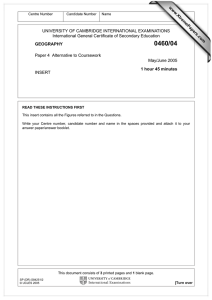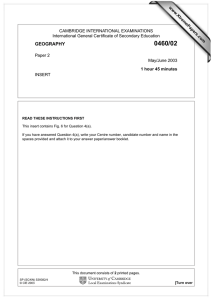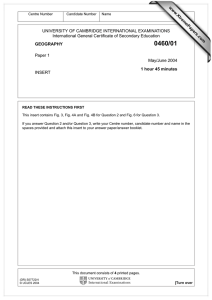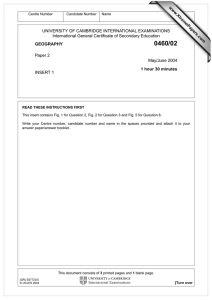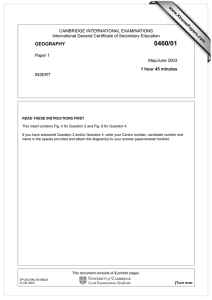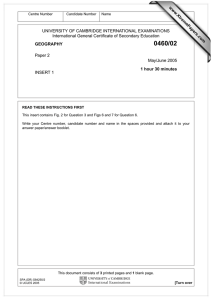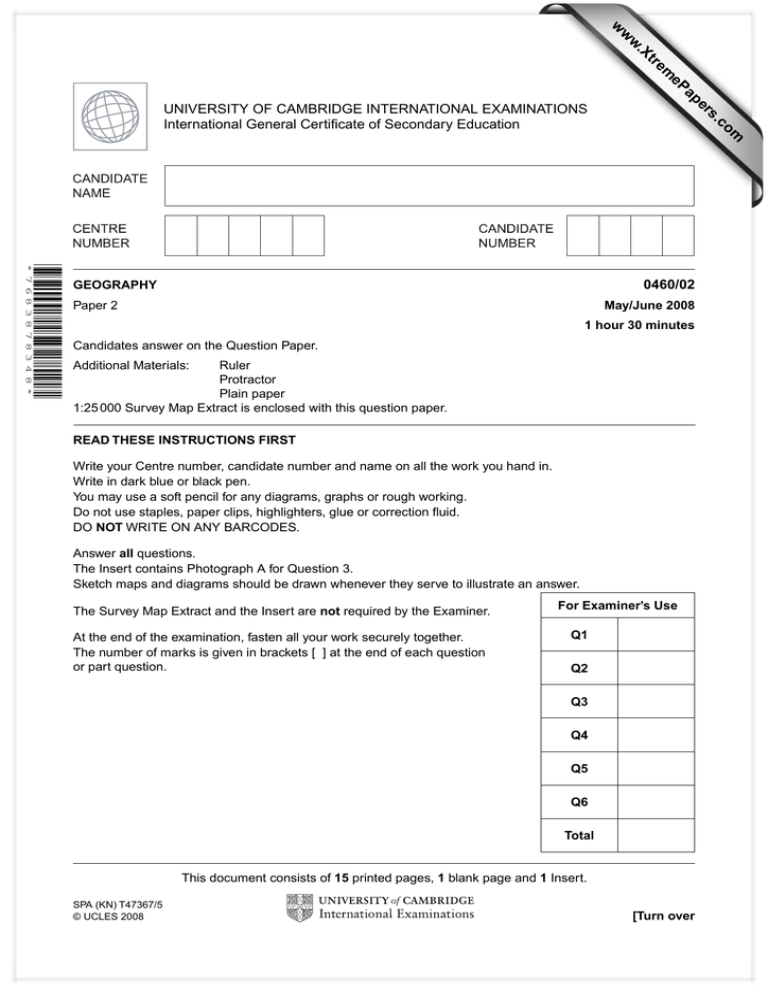
w
w
ap
eP
m
e
tr
.X
w
om
.c
s
er
UNIVERSITY OF CAMBRIDGE INTERNATIONAL EXAMINATIONS
International General Certificate of Secondary Education
*7683878348*
0460/02
GEOGRAPHY
Paper 2
May/June 2008
1 hour 30 minutes
Candidates answer on the Question Paper.
Additional Materials:
Ruler
Protractor
Plain paper
1:25 000 Survey Map Extract is enclosed with this question paper.
READ THESE INSTRUCTIONS FIRST
Write your Centre number, candidate number and name on all the work you hand in.
Write in dark blue or black pen.
You may use a soft pencil for any diagrams, graphs or rough working.
Do not use staples, paper clips, highlighters, glue or correction fluid.
DO NOT WRITE ON ANY BARCODES.
Answer all questions.
The Insert contains Photograph A for Question 3.
Sketch maps and diagrams should be drawn whenever they serve to illustrate an answer.
The Survey Map Extract and the Insert are not required by the Examiner.
At the end of the examination, fasten all your work securely together.
The number of marks is given in brackets [ ] at the end of each question
or part question.
For Examiner’s Use
Q1
Q2
Q3
Q4
Q5
Q6
Total
This document consists of 15 printed pages, 1 blank page and 1 Insert.
SPA (KN) T47367/5
© UCLES 2008
[Turn over
For
Examiner’s
Use
2
1
The map extract shows part of the island of Mauritius. The scale is 1:25 000.
(a) Fig. 1 shows the positions of some features in the north east of the map extract.
90
A
C
89
B
D
88
98
99
00
01
Fig. 1
Study the map and Fig. 1 and name the following features:
(i)
feature A;
.............................................................................................................................. [1]
(ii)
the plantation crop at B;
.............................................................................................................................. [1]
(iii)
the class of road at C;
.............................................................................................................................. [1]
(iv)
the named or public building at D.
.............................................................................................................................. [1]
(b) Describe the overall street pattern in the built-up areas of the map.
..........................................................................................................................................
...................................................................................................................................... [1]
© UCLES 2008
0460/02/M/J/08
3
(c) Look at the B4 St Paul Road from the junction with the B3 at Vacoas (954884) to the
junction with the A10 at St Paul (981898).
(i)
For
Examiner’s
Use
Measure the distance along the road. Give your answer in metres.
........................................................... metres
(ii)
Measure the bearing, from grid north, of the road from Vacoas to St Paul.
........................................................... degrees
[2]
(d) State the six figure grid reference of the roundabout (circle) at the junction of the B5 and
A10 roads at Curepipe.
...........................................................
© UCLES 2008
0460/02/M/J/08
[1]
[Turn over
4
(e) Fig. 2 shows two settlement areas shown on the map. These are grid square 9787 at
Floreal and grid square 9986 at Curepipe.
88
FLOREAL
87
CUREPIPE
86
97
98
99
00
Fig. 2
Table 1 compares the features of the two grid squares. Complete the table by putting
ticks in the correct six boxes. Use only one tick for each row.
Example: CBD
Floreal
(9787)
Curepipe
(9986)
Neither of these
areas
–
✓
–
River
Motorway
Low building
density
High order services
Flat land
Land sloping down
to the north west
[6]
Table 1
© UCLES 2008
0460/02/M/J/08
For
Examiner’s
Use
5
(f)
Fig. 3 shows the road from point X at the western edge of the map (920869) to point Y
(934875).
For
Examiner’s
Use
88
Y
87
X
86
92
93
94
Fig. 3
Describe the land-use and relief seen on a journey from X to Y along the road.
Land-use ..........................................................................................................................
..........................................................................................................................................
..........................................................................................................................................
..........................................................................................................................................
..........................................................................................................................................
...................................................................................................................................... [3]
Relief ................................................................................................................................
..........................................................................................................................................
..........................................................................................................................................
..........................................................................................................................................
..........................................................................................................................................
...................................................................................................................................... [3]
[Total: 20 marks]
© UCLES 2008
0460/02/M/J/08
[Turn over
For
Examiner’s
Use
6
2
Study Fig. 4, which shows the ideal growth conditions for coral.
sea temperature
LOW
water clearness
HIGH
water depth
salt content of water
wave action
= ideal growth conditions for coral
Fig. 4
(a) Fig. 5 shows the distribution of coral reefs in the world.
PACIFIC
OCEAN
ATLANTIC
OCEAN
23½ °N
Tropic of
Cancer
Equator
0°
Tropic of Capricorn
23½ °S
INDIAN
OCEAN
Key
Coral reef
Warm ocean current
Cold ocean current
Fig. 5
(i)
Between which lines of latitude is coral found?
.............................................................................................................................. [1]
(ii)
Using Fig. 4, suggest one reason for this.
..................................................................................................................................
.............................................................................................................................. [1]
© UCLES 2008
0460/02/M/J/08
7
(iii)
Suggest why there is coral on the east coast of southern Africa but not on the west
coast.
For
Examiner’s
Use
..................................................................................................................................
..................................................................................................................................
..................................................................................................................................
.............................................................................................................................. [2]
(b) Fig. 6 shows a map of an island and a coral reef.
main wind direction
Key
coral reef
stream
2m
70m
place B
am
sea depth
(metres)
2m
island
place A
e
str
N
0
1
2
km
Fig. 6
Environmental conditions do not allow coral to grow at places A and B on the map. Using
Fig. 4, for each place, suggest reasons why this is so.
Place A ............................................................................................................................
..........................................................................................................................................
..........................................................................................................................................
..........................................................................................................................................
Place B ............................................................................................................................
..........................................................................................................................................
..........................................................................................................................................
...................................................................................................................................... [4]
[Total: 8 marks]
© UCLES 2008
0460/02/M/J/08
[Turn over
8
3
Study Photograph A (Insert), which shows an area in southern Europe. Describe the relief,
settlement and agriculture of the area shown in the photograph.
Relief .......................................................................................................................................
.................................................................................................................................................
.................................................................................................................................................
.................................................................................................................................................
.................................................................................................................................................
.................................................................................................................................................
.................................................................................................................................................
.................................................................................................................................................
.................................................................................................................................................
Settlement ...............................................................................................................................
.................................................................................................................................................
.................................................................................................................................................
.................................................................................................................................................
.................................................................................................................................................
.................................................................................................................................................
.................................................................................................................................................
.................................................................................................................................................
.................................................................................................................................................
© UCLES 2008
0460/02/M/J/08
For
Examiner’s
Use
9
Agriculture ...............................................................................................................................
For
Examiner’s
Use
.................................................................................................................................................
.................................................................................................................................................
.................................................................................................................................................
.................................................................................................................................................
.................................................................................................................................................
.................................................................................................................................................
.................................................................................................................................................
............................................................................................................................................. [8]
[Total: 8 marks]
© UCLES 2008
0460/02/M/J/08
[Turn over
10
4
Study Fig. 7, which gives information about high technology industries, and Fig. 8, which shows
the location of Silicon Valley, an important centre for high technology industries in the USA.
High technology industries
These industries involve making and using silicon chips, computers, semi-conductor devices
and computer-controlled machinery. The location of these industries does not depend on the
factors which affect the location of many other more traditional manufacturing industries.
Important factors include:
•
•
•
•
•
a highly educated, specialised workforce
proximity to research facilities
nearness to other high-tech industries so that ideas, staff and equipment can be
shared
nearness to large urban markets is useful but high-value, low-bulk goods can bear
the cost of transport, often to overseas markets
a pleasant environment for the workforce to live in
Fig. 7
N
Berkeley
Mt. Diablo
1167 m
Oakland
l o
a b
D i
SAN
FRANCISCO
n
Sa
y
Ba
e
n g
R a
co
cis
an
Fr
Fremont
S
a
n
t
a
Palo Alto
C
Mountain
View
r
u
Sierra Morana
702 m
San Jose
z
Cupertino
M
t
Pacific
Ocean
s
0
Key
airport
university
boundary of built-up area
Fig. 8
© UCLES 2008
Sunnyvale
Santa Clara
0460/02/M/J/08
km
Silicon Valley (many high
technology companies)
30
For
Examiner’s
Use
11
(a) Using Fig. 8, estimate the maximum length and width of the Silicon Valley area.
Length .................................................km
Width ..................................................km
[1]
(b) Using Figs 7 and 8, describe the advantages of Silicon Valley for the location of high
technology industries.
..........................................................................................................................................
..........................................................................................................................................
..........................................................................................................................................
..........................................................................................................................................
..........................................................................................................................................
..........................................................................................................................................
..........................................................................................................................................
..........................................................................................................................................
..........................................................................................................................................
..........................................................................................................................................
..........................................................................................................................................
..........................................................................................................................................
..........................................................................................................................................
...................................................................................................................................... [5]
(c) Why is the availability of local raw materials not an important factor in the location of
high technology industries?
..........................................................................................................................................
..........................................................................................................................................
..........................................................................................................................................
...................................................................................................................................... [2]
[Total: 8 marks]
© UCLES 2008
0460/02/M/J/08
[Turn over
For
Examiner’s
Use
12
5
Table 2 shows weather information for Pretoria, South Africa, for five days in 2006.
date
maximum
temperature
(°C)
minimum
temperature
(°C)
pressure
(mb)
relative
humidity
(%)
July 29
22
2
1025
26
July 30
22
2
1023
22
July 31
20
7
1019
Aug 1
22
1
1015
31
Aug 2
18
2
1020
29
Table 2
(a) Fig. 9 shows the temperatures for the five days.
30
temperature
(°C)
20
MAXIMUM
10
MINIMUM
July
29
July
30
July
31
Aug
1
Aug
2
Fig. 9
(i)
Use the information in Table 2 to complete Fig. 9.
(ii)
Which date has the greatest range of temperature?
[2]
.............................................................................................................................. [1]
(iii)
The units of pressure are abbreviated as mb. What does mb stand for?
.............................................................................................................................. [1]
© UCLES 2008
0460/02/M/J/08
13
(b) The relative humidity for July 31 has been omitted from Table 2. This can be calculated
from the readings of the wet and dry bulb thermometers (hygrometer), shown in Fig. 10,
and the conversion table, shown in Table 3.
For
Examiner’s
Use
dry bulb
B
–10
–5
0
5
10
15
20
25
30
–10
–5
0
5
10
15
20
25
30
wet bulb
wick
distilled water
Fig. 10
wet bulb depression (°C)
dry
bulb
reading
(°C)
1
2
3
4
5
6
7
8
9
%
%
%
%
%
%
%
%
%
24
92
84
77
69
62
56
49
43
37
22
92
83
76
48
61
54
47
40
34
20
91
83
74
66
59
51
44
37
30
18
91
82
73
65
56
49
41
34
27
Table 3
(i)
State the readings of the wet and dry bulb thermometers in Fig. 10.
Wet bulb ........................................................
Dry bulb ........................................................
(ii)
[1]
Calculate the depression of the wet bulb.
.............................................................................................................................. [1]
(iii)
Using your answers to (b)(i) and (ii) and Table 3, state the relative humidity for
July 31.
.............................................................................................................................. [2]
[Total: 8 marks]
© UCLES 2008
0460/02/M/J/08
[Turn over
For
Examiner’s
Use
14
6
Four types of graph used in geography are:
•
•
•
•
a triangular graph
a bar graph
a scatter graph
a line graph
For each of the following four examples, (a) – (d), choose the most appropriate type of graph
from the list above. Name the type of graph and draw a labelled sketch of it.
You may use each type of graph once only.
(a) A graph to show rainfall totals for months of the year.
Name of type of graph .....................................................................................................
Labelled sketch
[2]
(b) A graph to show change in the birth rate over a number of years.
Name of type of graph .....................................................................................................
Labelled sketch
[2]
© UCLES 2008
0460/02/M/J/08
15
(c) A graph to show the relationship between birth rates and death rates in a group of
countries.
Name of type of graph .....................................................................................................
Labelled sketch
[2]
(d) A graph to show the percentages of primary, secondary and tertiary employment in a
group of countries.
Name of type of graph .....................................................................................................
Labelled sketch
[2]
[Total: 8 marks]
© UCLES 2008
0460/02/M/J/08
For
Examiner’s
Use
16
BLANK PAGE
Copyright Acknowledgements:
Question 3 Photograph A
Question 4
Map
D. Kelly © UCLES.
Fig. 8 © Brian Price, Paul Guinness; North America: An Advanced Geography; Hodder Arnold H&S; 1997.
Reproduced by permission of Ordnance Survey on behalf of HMSO © Crown copyright (2007). All rights reserved. Ordnance
Survey Licence number 100046560.
Permission to reproduce items where third-party owned material protected by copyright is included has been sought and cleared where possible. Every
reasonable effort has been made by the publisher (UCLES) to trace copyright holders, but if any items requiring clearance have unwittingly been included, the
publisher will be pleased to make amends at the earliest possible opportunity.
University of Cambridge International Examinations is part of the Cambridge Assessment Group. Cambridge Assessment is the brand name of University of
Cambridge Local Examinations Syndicate (UCLES), which is itself a department of the University of Cambridge.
© UCLES 2008
0460/02/M/J/08

